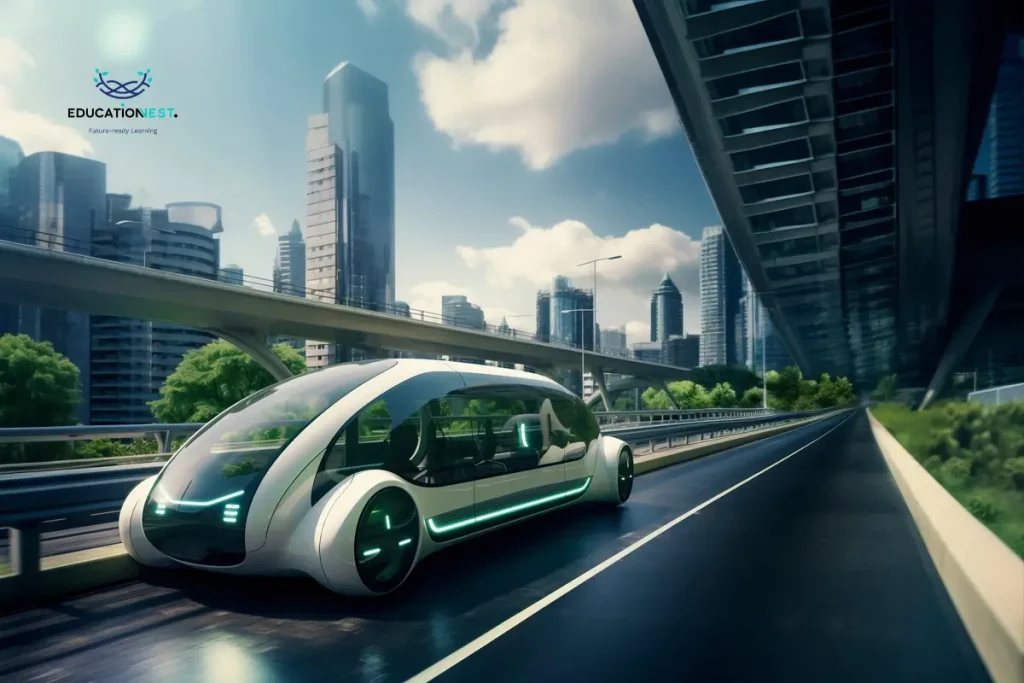Self-driving cars and smart cities are no longer ideas in science fiction books. They are becoming a reality, thanks to machine learning. ML is changing the way everything from the way we get around to how our cities look.
You can sit in cars that know exactly when to stop, change lanes, and where to park – all without you lifting a finger. Cities can now predict when and where traffic jams will happen. A lot like science fiction but these are very much possible through ML.
In this blog, we will discuss some of these fantastic use cases of ML that look straight out of fiction books and how you can hop onto the bandwagon.
Role of ML in self-driving cars
ML is what makes self-driving cars so smart. It helps them understand what is happening around them to make decisions in real time, without needing a human. But how do these cars actually see? How do they learn to drive on their own? That is where machine learning comes in. Here is how ML helps build self-driving cars:
Supervised Learning
The process is the same as teaching something to a child. ML first shows a lot of examples – like pictures of stop signs, pedestrians, or other cars. It teaches the car what each one is. Over time, the car gets better at recognizing these objects on the streets and can make the right decision when it sees them on the road.
Unsupervised Learning
This is how the car figures things on its own. It looks at all the data it collects and tries to find hidden patterns that might not be obvious. The car might notice that certain routes tend to be faster at certain times of the day (even if it has not specifically been taught that). This is an example of unsupervised learning in self-driving cars.
Reinforcement Learning
This ML process is like trial and error. The car tries out different actions, like making a turn or stopping at an intersection. It gets feedback based on whether those actions were good or bad. If the car avoids an obstacle or stays within the lane, it gets a “reward.” If it makes a mistake, it learns to avoid that next time.
Together, these types of ML help self-driving cars “understand” and “react” to the road.
Role of ML in Traffic Management
ML is already making a big difference in how we manage traffic. Instead of just reacting to traffic problems, ML is helping cities predict issues beforehand. It can help keep traffic flow smooth without the usual slowdowns. It is all about making traffic systems smarter by using real-time data. Here is a brief explanation of ML applications in traffic control:
Optimizing Traffic Lights
One of the most interesting ways is how ML optimizes traffic lights. In the past, traffic lights operated on a fixed schedule or relied on sensors that detected how many cars were waiting at an intersection. But with ML, the traffic lights can now “think” for themselves.
They can now “see” the actual flow of traffic. They can “see” if one direction of traffic is getting more cars than usual. The green light can stay on for a few more minutes to relieve congestion there.
Predictive Traffic Systems
Another huge benefit of machine learning in traffic management is prediction. ML can access vast amounts of historical traffic data, weather forecasts, and even data on local events (like festivals). ML can predict when and where traffic will get heavy.
This means that the traffic system does not wait for a jam to happen. It can forecast it to take action beforehand. The system might suggest alternate routes for drivers before they hit the backup. Forecasting ahead of time means drivers can avoid the worst delays within the city.
Real-time Traffic Monitoring
Real-time traffic monitoring is another application of machine learning. Cameras and sensors placed along roads constantly feed data into ML models to help them analyze situations on the road instantly.
If there is an accident or a car breaks down, the system can detect it right away. It can act instantly to reroute traffic. It can send out alerts to drivers. ML can also identify problems like slow-moving traffic, traffic violations, etc. It can respond accordingly in real-time.
If you want to help governments make a change in these areas, the best way is to build a workforce skilled in machine learning who knows the ins and outs and can apply ML to solve such big problems.
If you are looking for such programs in India, EducationNest is the best corporate training provider to join hands with. They have the best courses on AI and ML in India led by experts which are perfect for companies in the innovation field.

Read More
Top 5 Employee Well-Being Trends HR Leaders Should Know in 2025
How Cloud Computing and DevOps Work Together
Role of ML in Urban Planning
ML is quickly changing the game in urban planning. We will now be able to experience smart cities – more efficient and more livable. Traditional urban planning is too long and a slow process. And even then, the cities are not half as smart as what ML can help build. Here is how ML is helping in urban planning:
Predicting Growth
One of the key uses of ML is predicting growth patterns. Cities are constantly evolving. With populations growing and new businesses opening, city infrastructure needs to keep up. ML models can analyze data on everything – from population growth to housing demand. Planners can forecast where growth is likely to happen and what kind of development will be needed.
ML can help identify areas that are becoming overcrowded. It can point out areas that are still underdeveloped. Forecasting gives cities ample time to plan ahead and avoid problems like traffic jams, overcrowded schools, etc.
Optimizing Resource Distribution
This is another huge advantage of ML in urban planning. Urban areas need a lot of resources. Water, electricity, transportation, sewage – you name it. ML can help cities better allocate these resources by analyzing usage patterns and predicting future needs.
If an area is using more water than expected, or if electricity demand spikes during summers, ML can also suggest solutions for these issues. This not only reduces wastage but also makes life easier for their residents.
Smart Infrastructure
ML helps cities design and maintain infrastructure that can adapt to the people’s needs. Smart traffic systems are a small example of how ML helps in urban planning. ML can be used to monitor the condition of roads, bridges, and building infrastructure. It can predict when repairs will be needed in the future. Cities can cut down costs of emergency repairs.
Conclusion
This blog throws light on some of the ways ML can solve complex problems that we face every day in life. Traffic is a huge problem for populated countries like India. Managing and distributing optimal resources like water and electric supply are also some things we face in most big and small cities.
It won’t come as a surprise to see cities in India starting to use ML in urban planning. Hence, this is the perfect time to jump onto the bandwagon so that your company can join hands with the government when the time comes.
The best way to do this is to train your workforce starting now. It is the perfect time to invest in machine learning courses for your corporate teams if you want to cut into this profitable sector. If you are looking for such programs, EducationNest can help you in your training efforts with their expert-led training programs in India.
